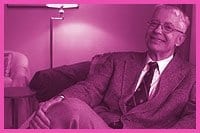It
was decades ago that Bob Tivey first encountered Miss Letros/Gay Toronto 1961.
“I was 18 and it was there at Letros that I first saw my first drag show. It
was amazing,” says Tivey. “These drag queens were fabulous and they all pulled
up in limousines. I clearly remember her getting out of the limousine and a man
yelled out, ‘That can’t be a guy, look at the legs!’ He was stunningly
beautiful.”
The moment was immortalized forever by the Toronto Telegram, a broadsheet rival
to the Toronto Star at the time. The paper ran a feature article on Miss Gay
Toronto with a photo of him coming out of that limo.
Back in 1961 Letros was the only all-gay cocktail lounge. While a number of
beer parlours in the city had gay sections (usually a corner of the bar), there
were no gay bars. The afterhours clubs also had no booze in the 1960s, serving
only coffee and soft drinks. You had to go to beer parlours and cocktail bars
for booze.
More than 40 years later Miss Letros, Neil Gilson, along with artist/writer/gay
history researcher John Grube and Rick Bébout, a member of the Body Politic
collective from 1977 to 1987, are being recognized as living legends at the
second annual Living Legends Night, put on by the Gay Men Over 40 Project.
“For me a living legend is someone who has made a difference in the community
in the past and is still doing so today,” says Tivey, who is part of the Gay
Men’s Community Development Program at the AIDS Committee Of Toronto.
“I didn’t do anything more than a lot of people did in those days,” says
Gilson.
Looking back at his life Gilson is proud of a number of his accomplishments,
including his 26-year relationship with his late partner, the relationship he’s
currently in and, he says, “the fact that as my hair-line recedes I have not
been so vain as to go out and get a toupee.”
And he’s proud of how far drag queens have come, marching in lockstep with the
progress of the community.
“I like the fact that I can walk on Church St and see people dressed up in drag
walking on the street in broad daylight and nobody bats an eye.”
Tivey says this year’s legends are also bound by their being survivors,
particularly of HIV/AIDS.
“Our community is based on lots of connections and relationships and those,
except for people who die, stick around,” says Bébout, 53, who has lived with
HIV for a long time. He gives Toronto tours to queer youth teaching them about
the city’s lesbian and gay history.
On being considered a living legend: “I’m surprised by it. I thought, oh well,
I can live with that for a night.”
The oldest of the trio is 73-year-old Grube. He’s also the most direct.
“I sill have an active sex life,” says Grube. “I like to check out the boys at
Sneakers playing pool and see who I’ll go home with.”
So how does a 73-year-old pick up boys half-a-century younger than himself?
“At my age you either pay for it or you don’t get it,” says Grube.
Having been involved with the sit-ins in the 1950s as a university professor,
Grube misses those days.
“I miss flirting with the students, not that I would do anything with them.”
And while he “doesn’t know what it means” to be a legend, he is glad to be
appreciated.
“It’s really nice to be appreciated by one’s own group. the hardest people to
convince that you’re any good are your own.”
* The second annual Living Legends Night was held Jun 25 at the 519 Community
Centre (519 Church St).

 Why you can trust Xtra
Why you can trust Xtra


